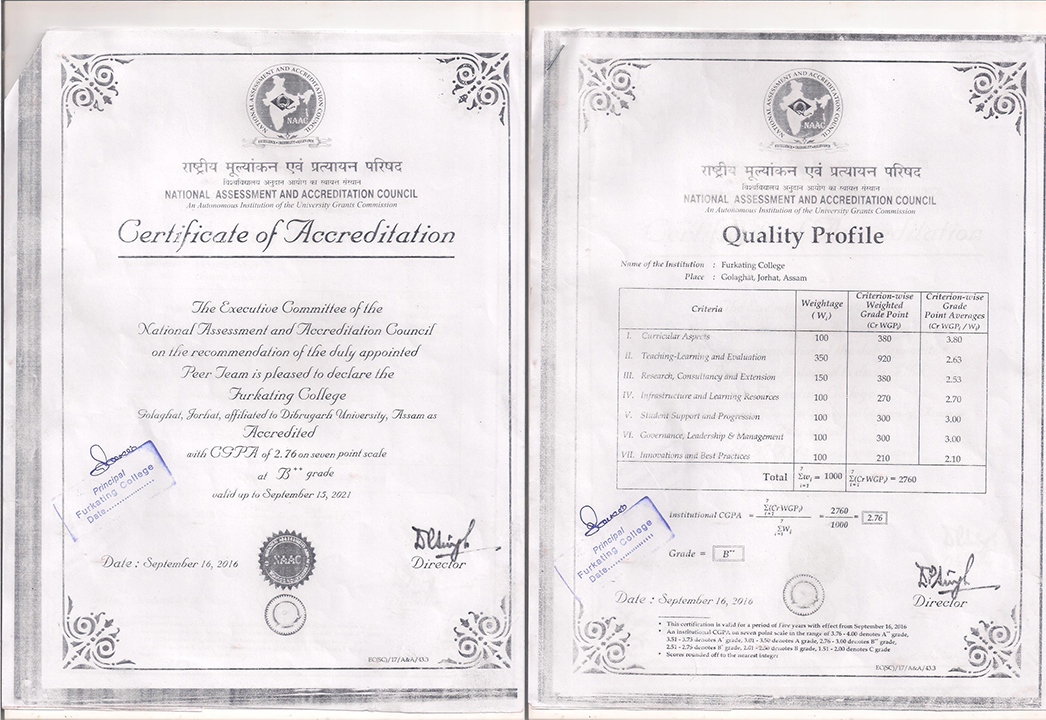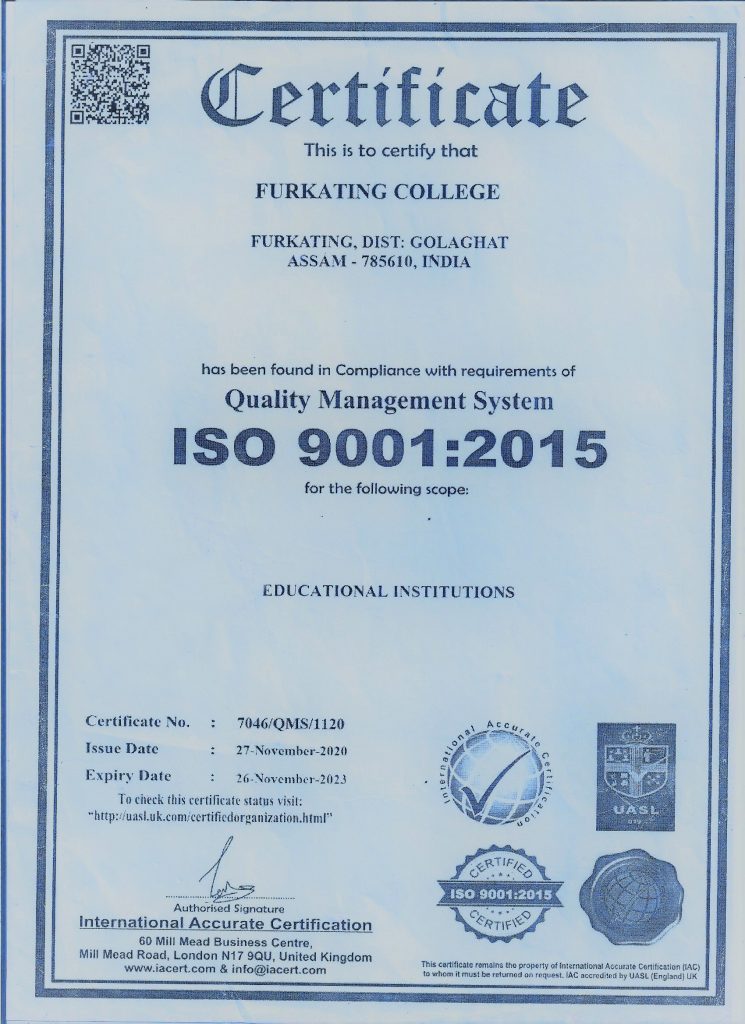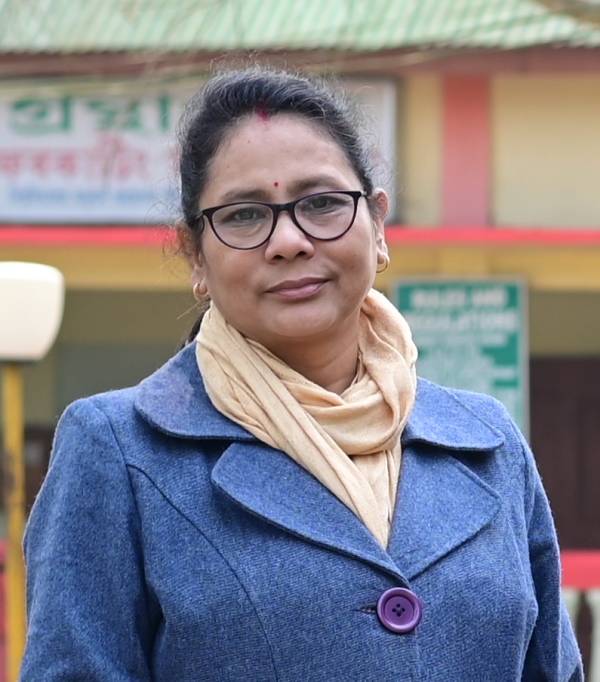
MRS INDIRA GOGOI
COORDINATOR IQAC FURKATING COLLEGE
Designation : ASSOCIATE PROFESSOR `
Department : ENGLISH
Contact No. : 9435515241
E-Mail : indiragogoi10@gmail.com

The Internal Quality Assurance Cell (IQAC) of Furkating College was constituted on 12/01/2004 Right from its establishment it has been involved in maintaining quality in different domains for the overall development of the institution.
The IQAC plans institutionalization of a number of quality assurance strategies and executes them accordingly. Some of those strategies at the beginning of the 4th cycle period include computerization of the academic as well administrative activities, awareness programmes on various issues of social relevance, more extension activities and outreach programmes, mandatory use of ICT in classroom teaching, monthly Appraisal Meetings of IQAC etc.
The IQAC has devised several mechanisms to review the effectiveness of the teaching-learning process. Adequate classrooms, quality instruments and equipment in the laboratories, mandatory use of ICT in classroom teaching, adequate books in the library, adequate number of computers in the lab, internet facility are some of the infrastructural facilities provided by the institution for assuring quality in the teaching-learning process. The IQAC reviews the activities carried out by different committees in its monthly Appraisal Meetings and suggests changes if any, so that the effectiveness of teaching-learning process is further enhanced.
The college has continued to move towards excellence also in the 4th cycle of accreditation by adopting some quality initiatives by the IQAC and implementing them successfully as well. Some of the quality initiatives both in the academic as well as in the administrative domain are mentioned here.
Academic domain:
- Organizing Orientation Programme for new comers
- Provision of adequate number of classrooms with ICT facilities
- Quality instruments and equipments in the laboratories
- Mandatory use of ICT in classroom teaching
- Adequate number of books in the library
- Adequate number of computers in the lab with internet facility
- Conduct of class tests, unit tests etc. regularly
- Conduct of review meetings immediately after the declaration of results of the final examinations
- Conduct of Faculty Development Programmes and training programmes for the teachers and the non-teaching staff of the district at least once in a year
- Compulsory tutorial classes and special classes for the slow learners
- Maintenance of teachers’ diary which are checked by the Principal periodically
- Submission of Teachers’ Appraisal Report at the end of every year
- Organizing various seminars and workshops in national and state level with sponsorship from agencies like NAAC, UGC, ICSSR etc.
Administrative domain:
- Decentralization of power by appointing teachers, members from the non-teaching staff, parents, members from the local society etc. in various decision-making bodies
- Timely conduct of audit of various accounts of the institution
- Smooth conduct of all the examinations and timely declaration of the results of the internal examinations
- Timely submission of Annual Quality Assurance Report (AQAR) to NAAC
- Timely assessment and accreditation of the institution by NAAC
- Conduct of Appraisal Meetings of IQAC mandatorily at least once in a month
- Conduct of Parents/ Guardians meetings regularly
- Feedback from students, alumni and guardians are taken, analyzed and suggestions are implemented if felt necessary
IQAC Members

Dr. APURBA SAIKIA
PRINCIPAL

Mrs. INDIRA GOGOI
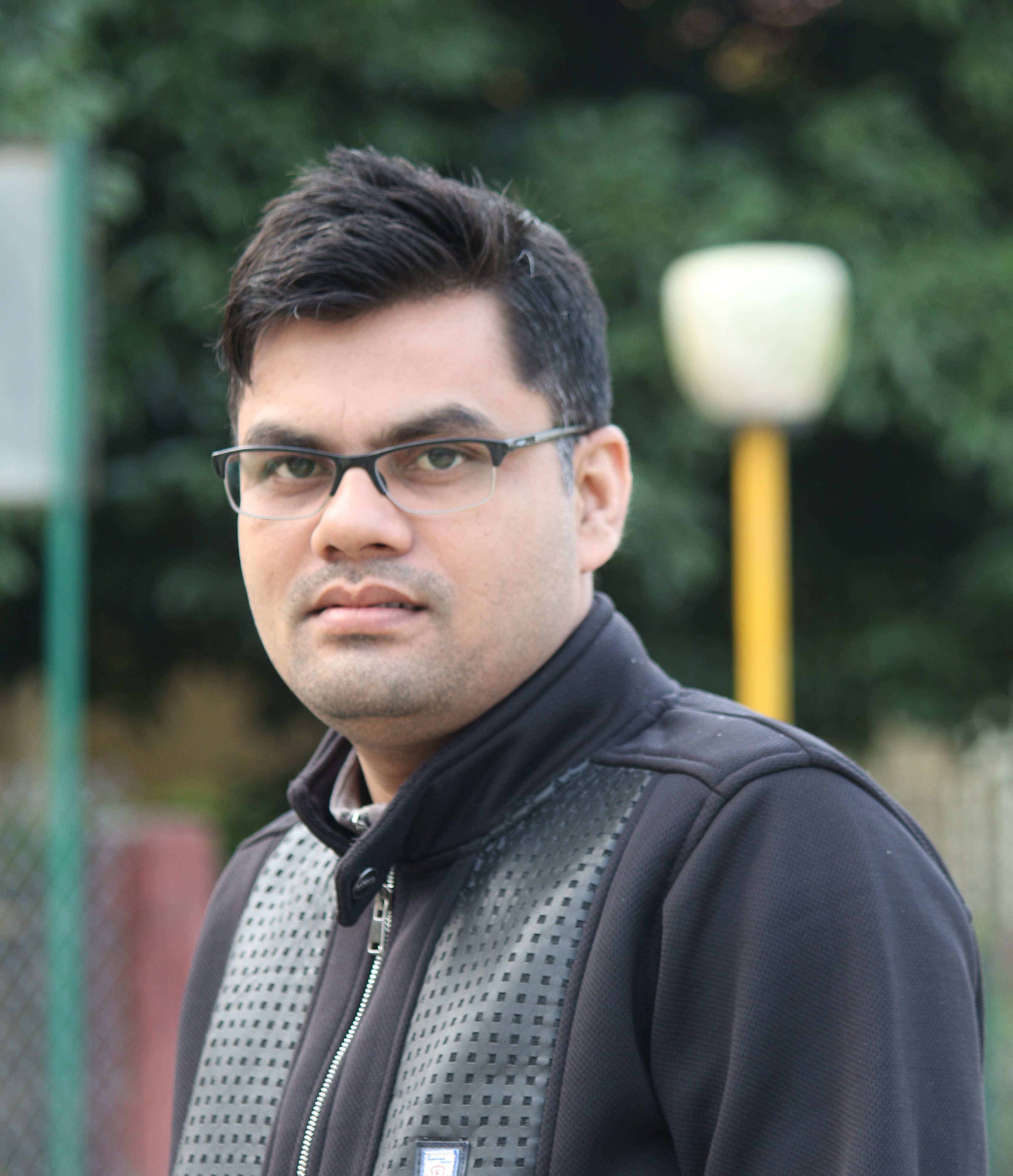
Dr. BINOD SARMA
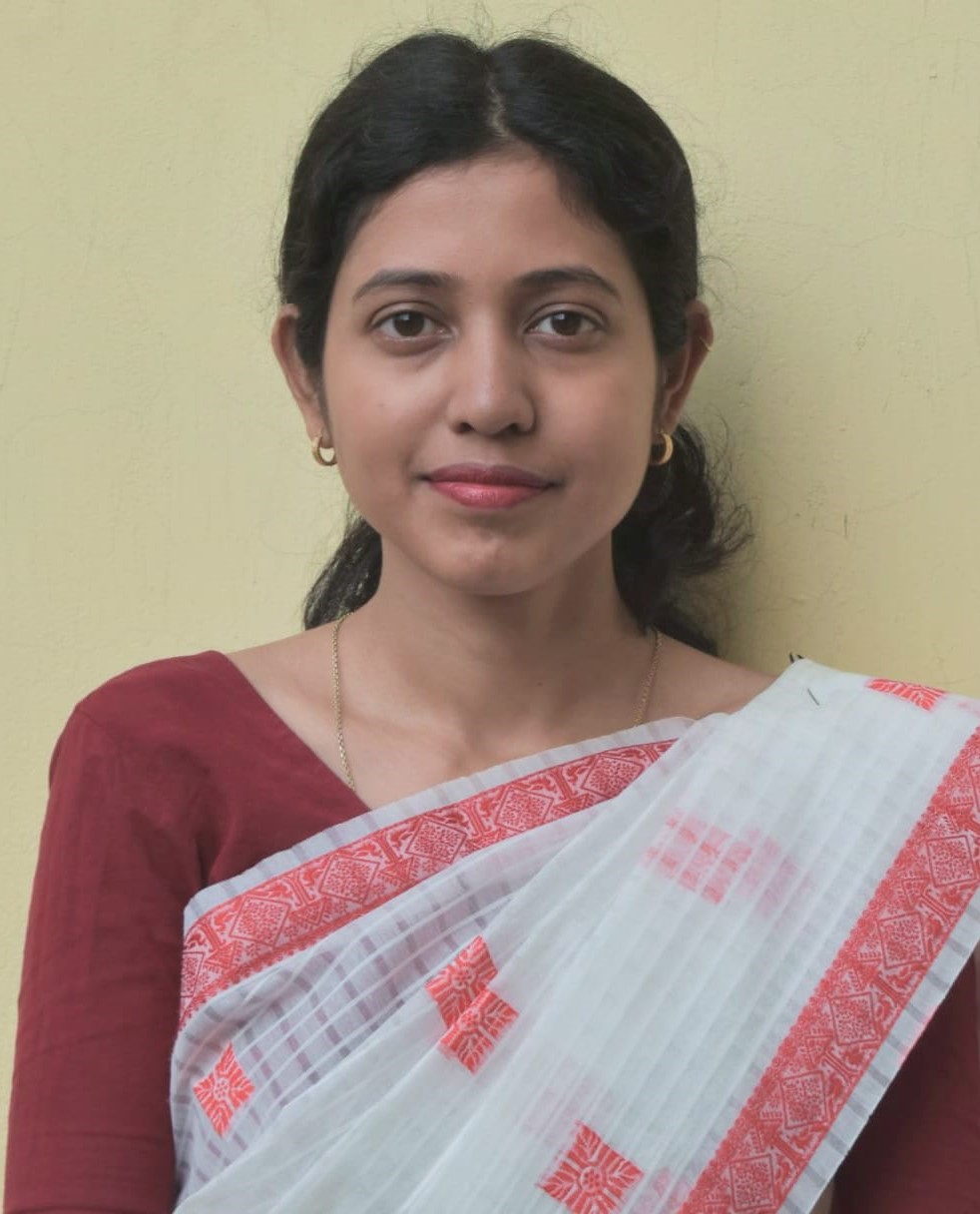
MISS ANTARA DUTTA
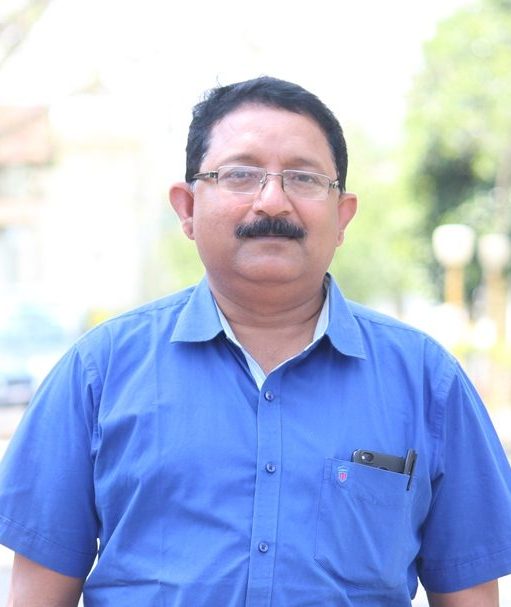
Dr. DEBASHIS BARUAH
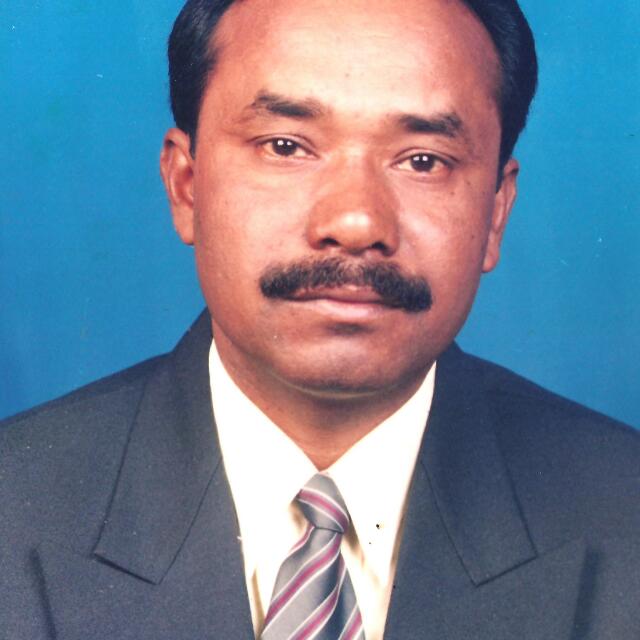
Mr. SIMANTA PODDAR
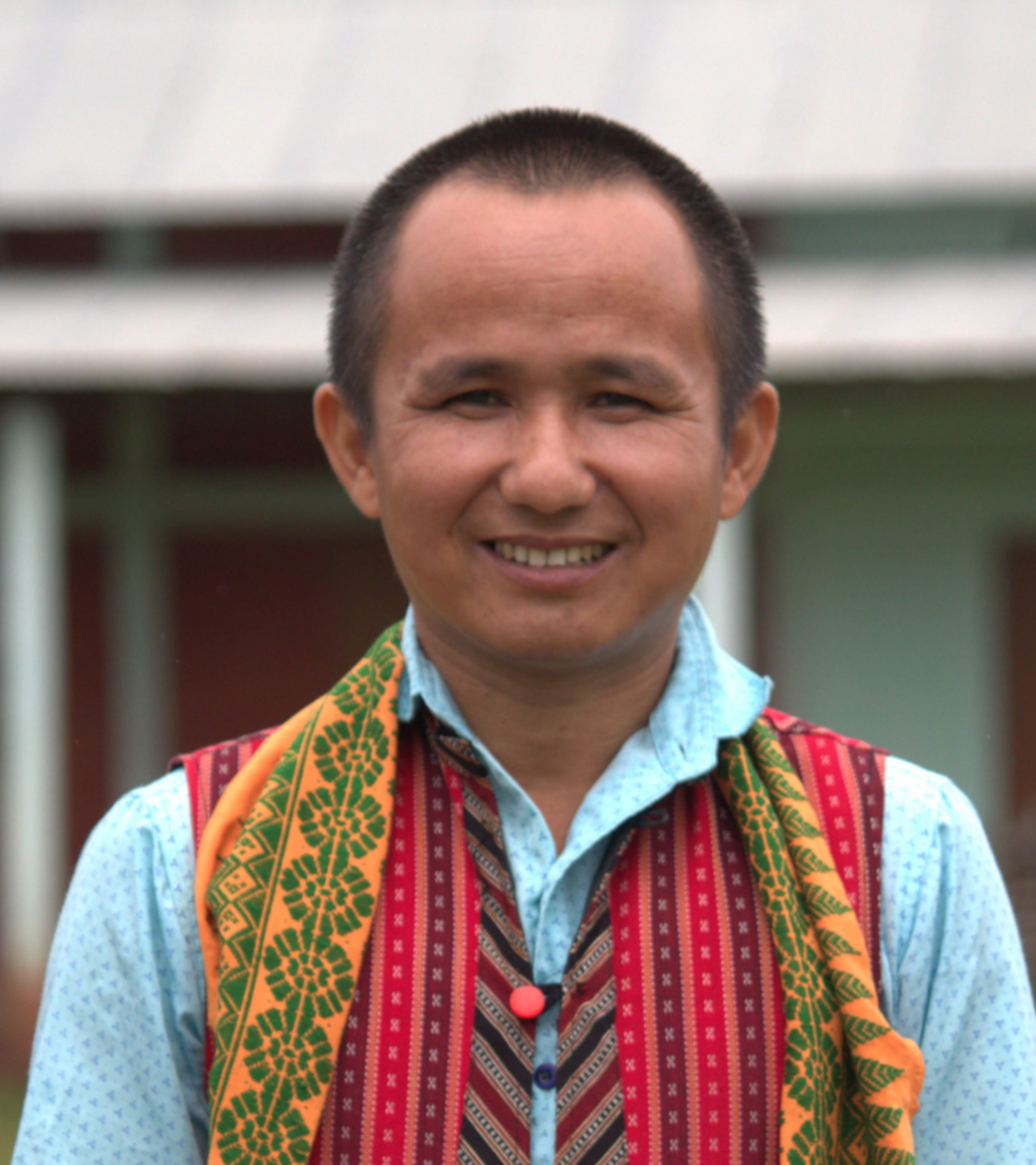
Mr. JATIN MECH
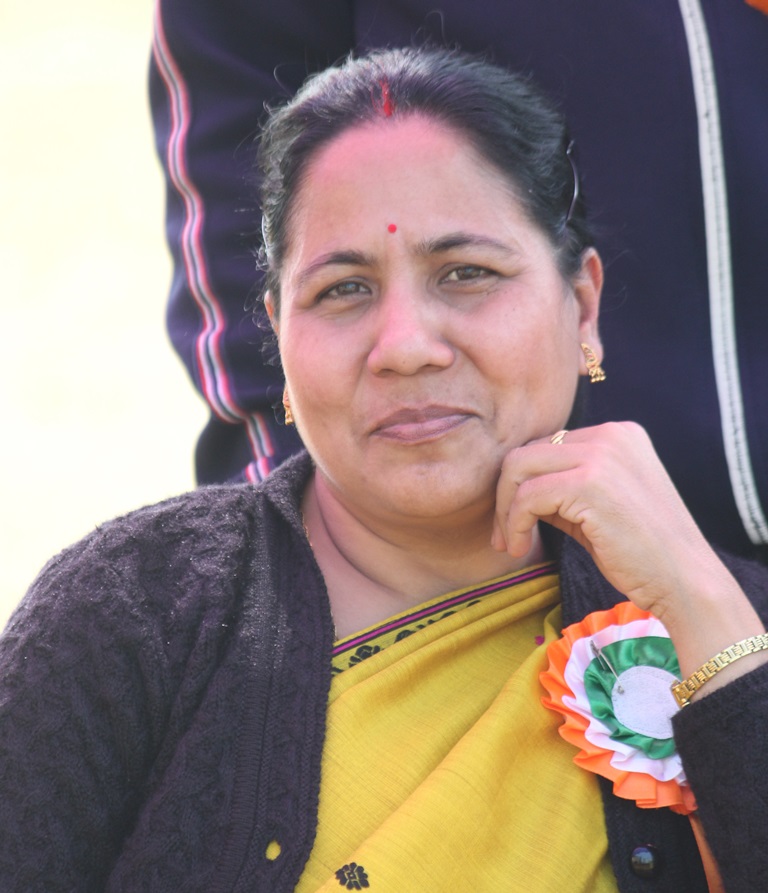
Dr. SWARNA PRAVA NATH
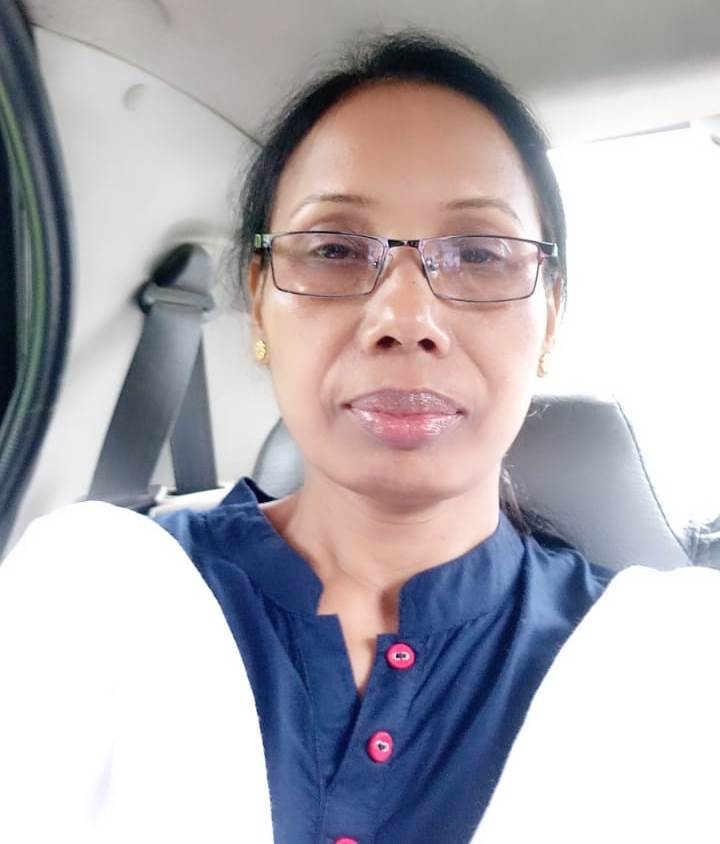
Dr. ROUSONARA BEGUM

Mr. DURLOVE BORAH
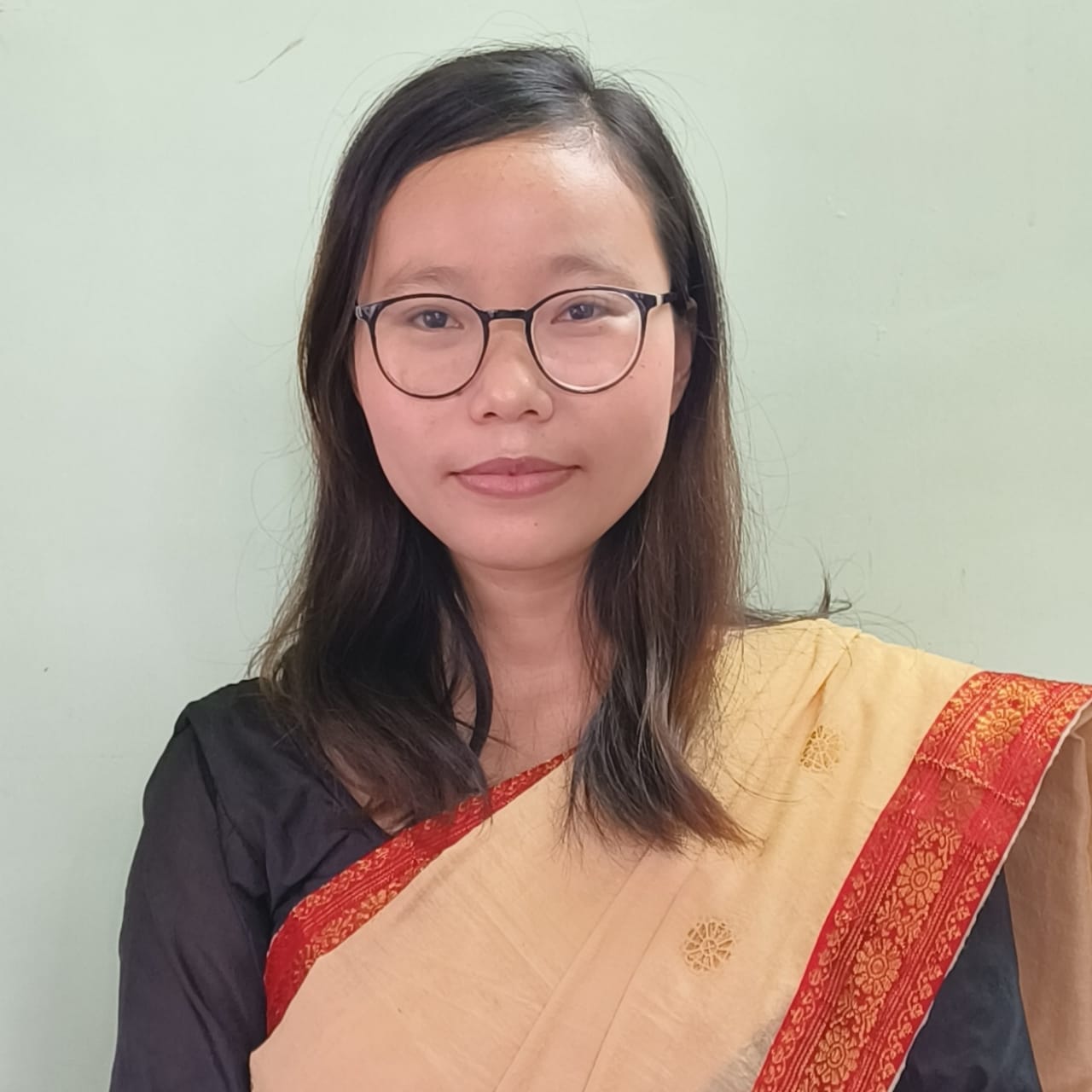
MISS INDINA SENARPI
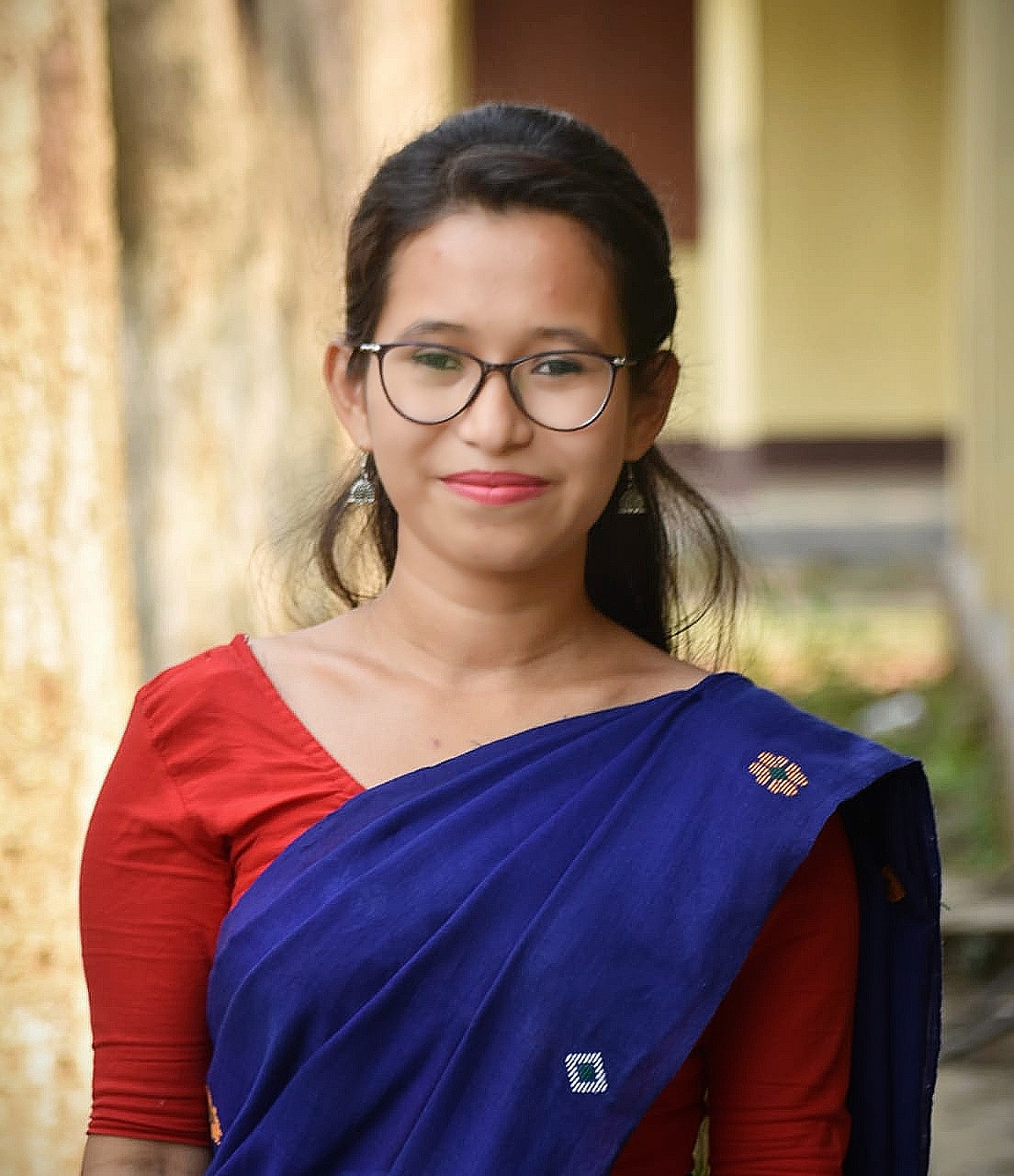
Mrs. ABHISHIKHA BAILUNG
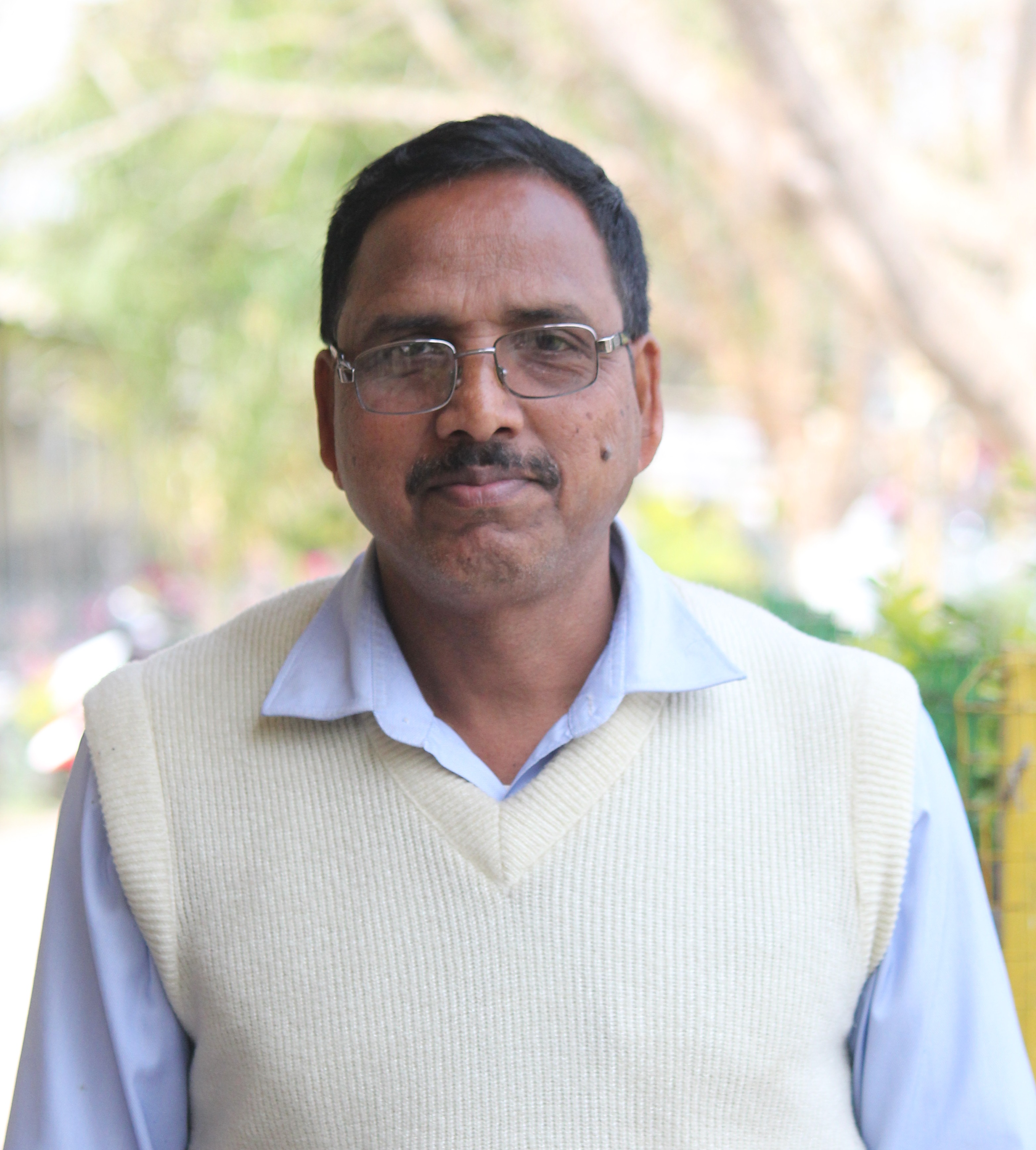
Mr. NIRMAL TURI
Mr. DIBYA NEOG
Mr. JIBONJYOTI PHUKAN
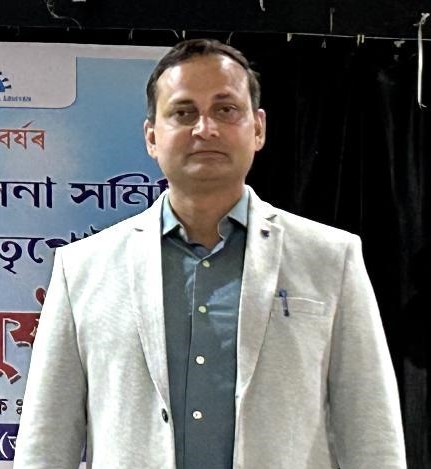
MR. PARSWAJYOTI SARMA
NAAC Accreditation Certificate
Click the Pictures to see large
Click the Pictures to see large
Click the Pictures to see large
Click the Pictures to see large
Best practice no: 1
Title of the practice: NAAC Assessment at the scheduled time.
Objectives of the practice: Assessment & accreditation by NAAC at the scheduled time has been considered as one of the two best practices by the college. It applies for NAAC Assessment within the validity period with the following objectives:
- To take the opportunity of self-evaluation & promote accountability & innovation in institutional activities.
- To inculcate core values.
- To focus on key indicators for quality enhancement & sustenance. .
- To maintain a work culture.
- To maintain continuity in all round development of the institution.
The context:
As the vision of the institution is ‘Preparing the learner for knowledge society and strengthening socio-economic base of the surrounding areas through quality higher education’, it tries to attain this goal by ensuring dynamism to the institution. And to bring this dynamism, the institution, in spite of having a number of limitations, invites NAAC for assessment within the time limit. As NAAC sets quality benchmark for various activities, the institution tries to carry out its day-to-day activities as per NAAC guidelines with a view to achieving its goals. In carrying out its day-to-day activities those activities leading to quality enhancement get priority.
The Practice:
The college was obtained UGC 12 (B) status in 2002. Prior to this there was no development in real sense. Internally there was no source to raise fund for development & the college was not eligible to apply for UGC fund .At that time infrastructure of the college was too poor to meet even classroom requirement of students. The college could not think of providing other amenities. During that period the college had to face two main problems- lack of fund for infrastructure development & lack of academic administrator to guide the institute . The college had to look for an alternative to pave its way for development. So, in 2003 the college took a bold decision to invite NAAC with the objective to prepare a road map of the college with the recommendation of academic expert of NAAC. Although the outcome of that assessment was C++, it could understand its strengths, weaknesses and also its opportunities in its way ahead. With the same spirit, the college invited NAAC for 2nd & 3rd Cycle Assessment in 2010 & 2016 respectively. In 2nd Cycle the college was placed in B grade (CGPA 2.63) & in 3rd Cycle assessment in B++ grade (CGPA 2.76). Gradual improvement in the outcome of NAAC assessment shows that overall quality of the institution has improved during the period.
Evidence of success:
NAAC assessment at the scheduled time has produced a number of positive outcomes to the institution. One important outcome the institution has experienced is that its infrastructural facilities have improved with the fund received from funding agencies like RUSA, UGC etc. Previously fund constraint was the biggest obstacle in the way of providing basic facilities to the students. Presently the college has 17 digital classrooms, well-furnished auditorium, indoor & outdoor sports facilities, auditorium, hostel facilities for boys & girls among others. With the strengthening of infrastructural facilities, quality of curricular, co-curricular, extracurricular activities have improved to a great extent. Evidence of successes is also found in achievement of students in curricular & extra-curricular activities. During last five years, eight students of the college have secured rank within first 10th position of the affiliating university. Similarly 82 (Eighty Two ) students have got medals in various sports & cultural competitions organized by the affiliating university & other institutes & 99 (Ninety Nine) of passed out students have been placed in various govt & semi-govt, private jobs, 71(Seventy One) passed out students have taken admission in higher educational institution during last five years. Evidences of successes are also clear on the other areas such as introduction of certificate/diploma courses, faculty publication, extension activities etc. One student of the college secured 9th rank at the state level in HS Final Exam in Arts conducted by Assam Higher Secondary Education Council. At the national level the college has been awarded 120th & 132th rank in single faculty college category in 2020 & 2021 respectively by Indian Today Magazine. Institutional strategy to carry out NAAC assessment at the scheduled time has been the contributing force behind all the evidences of successes.
Problems encountered and resource required:
- Insufficient staff, both teaching and non-teaching have been the biggest problem in conducting various quality enriching activities as stipulated by NAAC.
- Socio-economic background of majority of students not conducive to introduce & sustain quality initiatives. About 2/3 students are first generation learners & economically poor to bear expenses of higher education.
- Affiliating system & existing practices of the govt make it difficult to introduce new programme.
Best Practice No-2
Title of the practice: Higher education to underprivileged & downtrodden section of society
Objective of the practice:
With the vision of “Preparing the learners for knowledge society and strengthening socio-economic base of the surrounding area through quality higher education” the institution undertakes the best possible effort to provide higher education to the underprivileged & downtrodden section of society. As the majority of people of the surrounding areas belong to underprivileged and downtrodden section of society with limited access to higher education, the college provides them an opportunity of higher education with the following objectives:
- To nurture students’ inherent talent.
- To inculcate knowledge & skill necessary to face global competition.
- To prepare socially responsibility citizen.
- To extend the activities of the institution towards social benefit.
- To promote their personality & all-round development.
- To strengthen socio-economic base of people of surrounding areas.
The Context:
The College is located in a rural ambiance of the Assam-Nagaland Border in the Golaghat district of Assam. Except the college there is no institute of higher learning up to Assam-Nagaland border-an area of more than 30 KM. A significant percentage of students is enrolled from marginalized and socio-economically weaker section like ST, SC, and OBC category . More than 2/3 of students are first generation learners & 99 % vernacular background. The composition of students also show that around 30 % students belong to tea garden community–a community having lowest enrolment in higher education and socio-economically the most backward community of the state. Majority of the students belong to families with agriculture as the main source of livelihood & their average monthly income less than Rs5000/. In the absence of access to higher education, dream of many of the learners of the surrounding areas to pursue higher education would have remained unfulfilled. All these facts also indicate that the college works in an unfavourable situation to materialize its goal of providing access to higher education to the underprivileged & downtrodden section of society . It has a number of locational disadvantages too. But it is a matter of pride that the college has been able to overcome the challenges successfully.
The practice:
In spite of having number of limitations, the college has made quality education affordable & accessible by undertaking various initiatives. Taking in to account the poor socio-economic condition of the people of surrounding areas, the college gives the opportunity of enrolment to those students who can’t enrol in other institutes either due to low percentage of marks at the entry level qualification or poor economic condition. Free ship & scholarship provided by the government is made available to such students so that poor economic condition can’t stand as an obstacle in fulfilling their dream to pursue higher education. Besides free ship provided by the Government, scholarship such as Ishan Uday, Post Metric, Minority Scholarship, Financial Assistance from MLA, Free Text Book, Subsidy in Hostel Mess Dues etc are made available to the students. . .
The college gives equal importance on curricular, co-curricular & extra-curricular activities to develop inherent talent of its learners. Mentoring, personal & career counselling has been in operation to guide learners in promoting their all-round development. The college also arranges guidance session to prepare the students for various competitive exams & to get placement. To ensure that more students get placement the college has already introduced a UGC sponsored B Voc Programme in Hotel Management in association with the NSDC, New Delhi. Similarly to enhance employability of its learners the college has introduced a number of add-On/ Certificate Courses.
The college organizes inter-college events of the affiliating university to give a platform to its students to show their talent. Inter-college Football Tournament, Athletic Competition & Kick-Boxing Competition are some of the events the institution has organized during last five years. In every year more than 50 students participate in various tournaments across the country.
Evidence of success:
- Average pass percentage of the college has been at per with the pass percentage of the affiliating university. The cut off marks of majority of students enrolled by the college is in the range of 40-45 %. In spite of poor academic background of its learners at the entry level qualification, the college has been maintaining a healthy pass percentage.
- Every year student of different departments of the college get position among top ten position holders of the affiliating university. It is worth mentioning that during last five years total eight students of the college were among top ten students of the university.
- On an average 5-15 students of the College pursue higher studies in every year in some reputed higher educational institutes of the country. To remove barriers of progression to higher educational institution, the IQAC adopts a well-planned strategy to motivate the meritorious students to go for higher studies. Along with providing personal counseling, faculty members provide support in cash & kind to the needy students.
- Adequate exposure in the field of sports & culture to those students who have talent & potential. During last five years eighty two (15 in 2015-16,06 in 2016-17, 23 in 2017-18, 20 in 2018-19 and 18 in 2019-20) students of the college have won medals in various inter-college events organized by the affiliating university. So far as state & national level competition are concerned, a good number of students from the institution take part in different competitions. As a result of the institutional initiatives in the field of sports & culture a good number of students have brought accolades to the college in various competitions by winning medals.
- During the period 2015 to 2020, ninety nine students of the college have been appointed in governmental and non-governmental jobs. A good number of alumnus of the college have been engaged as school/college teacher, defense personnel, Hotel & Aviation industry, banks & other State/Central Government job.
Problems encountered and resource required:
- Insufficient staff and adverse socio-economic background are two major problems encountered by the institution in sustaining this practice. To solve this problem government should sanction additional post to the College.
- The tight university schedule of semester/CBCS system is the major obstacle faced by the institution. To overcome this obstacle the institution drafts an annual academic calendar incorporating all its activities so that the normal class routine is minimally affected.
- Another major problem encountered by the institution regarding this practice is that some students who have prospect in sports are compelled to discontinue their studies due to familial problems. The College authority tries to motivate and inspire these talented students for effective participation in the activities of their choice.
- The amount of scholarship should be increased to make the students economically sound to continue their studies.
- The contribution of corporate sector is the need of the hour for the marginalized & downtrodden students.
Best Practice – I (2023-24)
TITLE OF THE PRACTICE: INTEGRATED EMPLOYABILITY ENHANCEMENT PROGRAMMES
Objective of the practice:
- To equip students with both technical and soft skills for improved employability and self-reliance.
- To bridge the gap between academic knowledge and industry requirements through practical training and career planning.
- To create opportunities for entrepreneurship and self-employment alongside conventional employment avenues.
The Context:
While students excel academically, many lack the technical and soft skills required to thrive in today’s competitive job market. The feedback from recruiters and industry experts consistently highlights the need for practical training, certification, and career readiness. Recognizing this, the institution launched a two pronged approach:
- Skill Enhancement Courses under the PMKVY 4.0 scheme to provide industry-specific vocational training and certifications.
- Career Development Workshops focusing on career planning, interview readiness, and personal development to prepare students for professional environments .
The practice:
The institution adopted a holistic model by combining skill-based training with career development programmes:
- Skill Enhancement Courses under PMKVY 4.0:
- Sector-Specific Training: Courses like Professional Makeup Artist, Data Entry Operator, Junior Software Developer, and Assistant Electrician provide job-role-specific training aligned with PMKVY 4.0 guidelines.
- Certification Programmes: Students receive recognized certifications, validating their skills and enhancing employability.
- Entrepreneurship Skill Development: To support self-employment, the curriculum includes modules on starting a business, financial literacy, market analysis, and client management, particularly beneficial for roles such as Professional Makeup Artist, Bridal Makeup Artist, and Hair Dresser, where freelance and entrepreneurial opportunities are common.
- Industry Collaboration: The College collaborates with local beauty salons, software firms, and customer service agencies to provide practical training, real-world projects, and mentorship, offering students hands-on training and real-world exposure.
- Internship Opportunities: Facilitation of internships in high-demand sectors like IT, Makeup Artistry, hospitality, and customer service.
2. Career Development Workshops:
- Soft Skills Training: Sessions on communication, teamwork, leadership, and problem-solving by industry experts.
- Tata-Google Scholarship Programme: Awareness sessions on digital marketing and e-commerce opportunities.
- Career Counselling: Collaboration with Royal Global University for sessions on career planning and NEP implementation.
- Job Fairs: Connecting students with prospective employers through annual recruitment drives.
Evidence of success:
- A marked improvement in student confidence and job-specific skills.
- Over 20 students secured job offers through job fairs, with several venturing into self-employment and freelance work in fields like makeup artistry.
- Positive feedback from recruiters citing better preparedness and professionalism among participants.
- Increased participation in skill certification and career workshops, showcasing a growing interest in employability initiatives.
Problems encountered and resource required:
Challenges:
- Initial resistance from students who were unfamiliar with the benefits of skill certification programmes and lacked awareness about the importance of career workshops.
- Difficulty balancing academic priorities with additional training sessions.
- Limited awareness among students about self-employment opportunities.
Resources Required:
- Qualified trainers and industry experts.
- Infrastructure for hands-on training, workshops, and job fairs.
- Financial support for training materials and event organization.
Conclusion:
The integration of PMKVY 4.0 skill enhancement courses with career development workshops has proven to be a comprehensive approach to addressing employability challenges. By equipping students with technical certifications and soft skills, the institution fosters both immediate job readiness and long-term career growth.
Best Practice – II (2023-24)
TITLE OF THE PRACTICE: Community Engagement through NSS Activities
Objective of the practice:
- To foster social responsibility and active citizenship among students.
- To promote student involvement in community welfare, focusing on health, environment, and social issues.
- To develop leadership, teamwork, and service-oriented skills in students through real-world applications.
The Context:
Many students excel academically but lack exposure to hands-on community engagement. Through the National Service Scheme (NSS), students have opportunities to work on various community initiatives that build empathy, social awareness, and a sense of purpose beyond the classroom. The institution identified key community needs in areas such as health awareness, environmental conservation, and national unity. By engaging students in these activities, the college aimed to foster a generation of responsible, community-oriented individuals.
The practice:
The NSS unit conducted numerous community engagement programmes throughout the year, collaborating with various community, government, and non government organizations. Key activities included:
Blood Donation Camp: In collaboration with the Youth Red Cross Unit, Red Ribbon Club, and Alumni Association, the NSS organized a blood donation camp, engaging both students and teachers in addressing the local demand for blood supplies. This event fostered awareness of the importance of blood donation and contributed to saving lives in the community.
World AIDS Day Observance: In partnership with the Red Ribbon Club, Youth Red Cross Unit, NSS, and NCC Units, this activity focused on HIV/AIDS awareness. Through interactive sessions and educational materials, students raised awareness within the community, helping to reduce stigma and improve public understanding of HIV/AIDS prevention and treatment.
Environmental Awareness Programmes: On World Environment Day and World Bicycle Day, the NSS organized awareness and tree-planting events in collaboration with local industry partners, and NCC Unit. Students participated in activities to promote environmental sustainability and learned the importance of preserving natural resources.
National Observances and Social Awareness Campaigns: The NSS unit held activities such as Swachhta Abhiyan, National Sports Day, and National Unity Day, engaging students in cleanliness drives, sports events, and unity parades. This allowed students to participate in nation-building initiatives, reinforcing values of unity, cleanliness, and fitness.
Evidence of success:
- The blood donation camp collected several units of blood, assisting local hospitals and fostering a culture of regular blood donation among students.
- World AIDS Day activities resulted in increased awareness, with students reporting a greater understanding of HIV/AIDS and a decrease in stigma.
- Environmental programmes led to a tangible increase in environmental awareness, with students committing to sustainable practices and continued community tree-planting drives.
- Events such as National Unity Day and Swachhta Abhiyan strengthened students’ sense of civic duty, with active participation from over 100 NSS volunteers and NCC cadets across these programmes.
Problems encountered and resource required:
Challenges:
Limited student participation initially due to a lack of awareness about the significance of community service. To address this, the NSS unit organized pre-event orientations and motivational talks by alumni and community leaders.
Resources Required:
Support from community, logistics for event organization, materials for health awareness and environmental campaigns, and financial resources to manage transportation and event setup.


